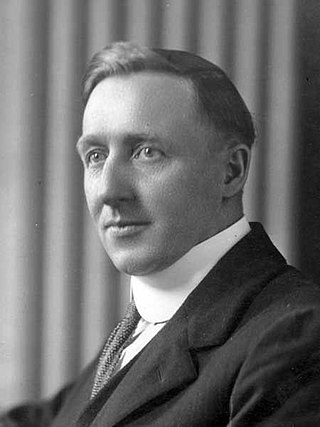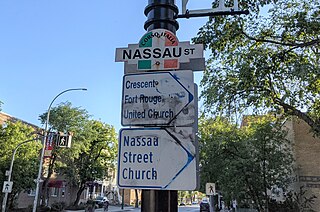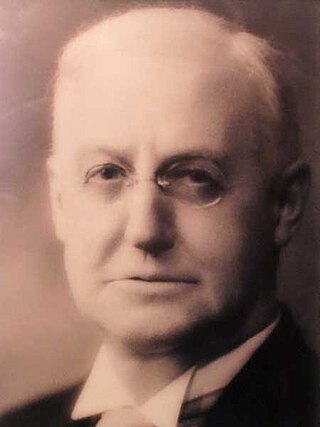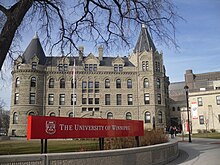
The University of Winnipeg is a public research university in Winnipeg, Manitoba, Canada, that offers undergraduate faculties of art, business and economics, education, science and kinesiology and applied health as well as graduate programs. UWinnipeg's founding colleges were Manitoba College and Wesley College, which merged to form United College in 1938. The University of Winnipeg was established in 1967 when United College received its charter. The governance was modeled on the provincial University of Toronto Act of 1906 which established a bicameral system of university government consisting of a senate (faculty), responsible for academic policy, and a board of governors (citizens) exercising exclusive control over financial policy and having formal authority in all other matters. The president, appointed by the board, was a link between the bodies to perform institutional leadership.

St. John's College is an Anglican-based independent constituent college of the University of Manitoba, located on the university's Fort Garry campus in Winnipeg, Manitoba.

William Ivens was a religious and political figure in Manitoba, Canada. He was a leading figure in the Winnipeg General Strike, and subsequently served as a Labour member of the Manitoba legislature from 1920 to 1936.

The Winnipeg Wesmen are the athletic teams that represent the University of Winnipeg in Winnipeg, Manitoba, Canada. As an undergraduate school, the Wesmen participate in the sports of basketball, volleyball, and soccer in both the men's and women's divisions of U Sports. All home games are played at the Duckworth Centre, located on the university's downtown Winnipeg campus. The Wesmen also compete in men's baseball, and are a single-sport member of the National Association of Intercollegiate Athletics (NAIA).
Manitoba College was a college that existed in Winnipeg, Manitoba, Canada, from 1871 to 1967, when it became one of the University of Winnipeg's founding colleges. It was one of the first institutions of higher learning in the city of Winnipeg and the province of Manitoba. The first graduating class had 12 members.

Charles William Gordon, CMG, also known as Ralph Connor, was a Canadian novelist, using the Connor pen name while maintaining his status as a church leader, first in the Presbyterian and later the United Church in Canada.

Nassau Street is a 2-kilometre (1.2 mi) street in Winnipeg, Manitoba, located partially within the Osborne Village and Fort Rouge neighbourhoods.

The amalgamation of Winnipeg, Manitoba, was the municipal incorporation of the old City of Winnipeg, 11 surrounding municipalities, and the Metropolitan Corporation of Greater Winnipeg (Metro) into a one Unified City of Winnipeg, or Unicity.

Alexander Christie was a Scottish fur trader and chief factor of the Red River Colony from 1833 to 1839 and from 1844 to 1848. Christie was instrumental in leading trading ceremonies on behalf of the Hudson's Bay Company (HBC) while he served in a role known as chief factor. When he retired, he received a half share in the company's profits for two years beyond the normal retirement period.

Charles Frederick Gray was a Canadian politician, the 27th Mayor of Winnipeg in 1919 and 1920.
Norman Criddle, born in 1875 in Addlestone, Surrey, England, died in 1933 in Winnipeg, Manitoba, Canada, was an entomologist active in the early development of control strategies for agriculturally important grasshoppers in the prairie croplands of western North America, as well as a naturalist-artist.
Lewis Benjamin Foote was a Canadian photographer, best known for his black-and-white photographs of early Winnipeg, including royal visits, the Winnipeg General Strike, and slums.
Harry Sherman Crowe (1922–1981) was a history professor, university administrator, and labour researcher. In 1958, his firing by United College gained national attention in Canada. In raising questions about the security of academic freedom and tenure in Canada, Crowe's case became a catalyst in solidifying the work of the Canadian Association of University Teachers (CAUT) in defending academic freedom and ensuring scholarly rights for academic staff in Canada.

Michael Graham Saunders was a Neurophysiologist, Medical Doctor, and Medical Researcher who was fundamental in the development of the Electroencephalography, as well as a strong advocate for the advancement of computer use in medicine.
Frank Trafford Taylor,, was a Canadian lawyer, and the president of Kiwanis International.
Alexander Johnson Musgrove (1881–1952) was a Scottish-born Canadian artist.

Walter Harley Trueman was a lawyer and a judge in Winnipeg, Manitoba.
Prof Ian Maclaren Thompson FRSE FRSC (1896–1981) was a Newfoundland anatomist and medical author.











